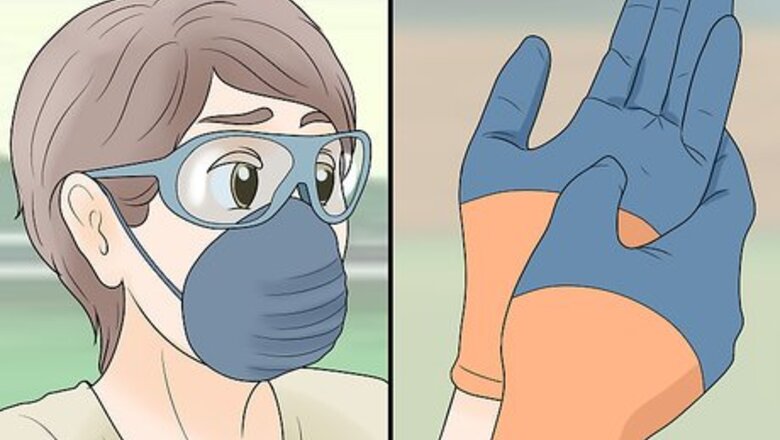
views
X
Research source
Whether you plan on keeping it or selling it, your car will look cleaner (and be worth more) without the rust, so don't hesitate to take immediate action. Remove the rust spots and give the car fresh coat of paint as early as possible to stop widespread rust damage before the spot has a chance to spread.
Buffing and Re-painting Rust Spots
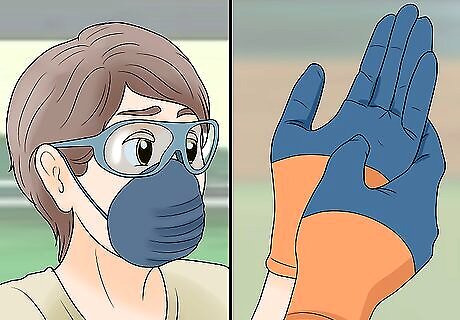
Take basic safety precautions. This method involves using a sander and a grinder — two powerful electric tools that can kick fine rust and paint dust into the air. To avoid injury and protect yourself from these airborne particles, be sure to wear gloves, safety glasses and especially a dust mask to keep the rust and paint particles out of your lungs. For heavy-duty jobs, consider using a respirator rather than a simple dust mask.

Mask any spots that you don't want to get dusty. As noted above, this job puts rust and paint particles in the air. If you're not careful, these can settle on your car, giving it a "dirty" appearance that can be hard to get off. To avoid this, "mask" the parts of your car that you're not working on (that is, cover them with tape and masking paper.) Use a tarp sealed with painter's tape under the car to define your work area and protect the floor. Masking the car off is a delicate art. Do not use newspaper, as paint spray can leak through it and leave unsightly specks. Instead, use real masking paper, which is less porous and won't let paint through. Also, be sure to tape every single edge of your masking paper down. Don't just use a few small pieces of tape to get it to stay in place — paint can (and will) work its way under any loose edges.
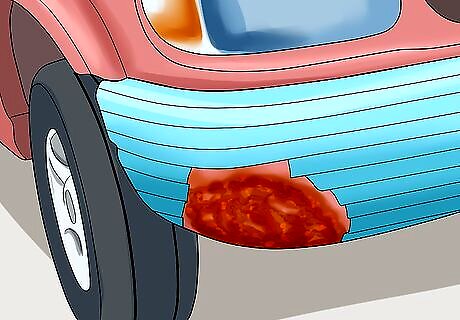
Try to mask along the existing panel lines. In general, you don't want your masking to stop in the middle of a panel, or you will be left with sharp lines where your new paint ends and the old paint begins. These lines do not go away with any amount of buffing or addition of clear coat layers, so practice prevention by masking the car correctly in the first place, stopping at the panel lines around your rust spots and going no farther inward. If you're experienced with auto painting, you might alternatively try stopping your masking a few panels back from your rust spot. If you know how to gradually blend paint, which is done when spraying, you can use this tactic to make it so that there isn't a drastic color difference between one panel and the next.
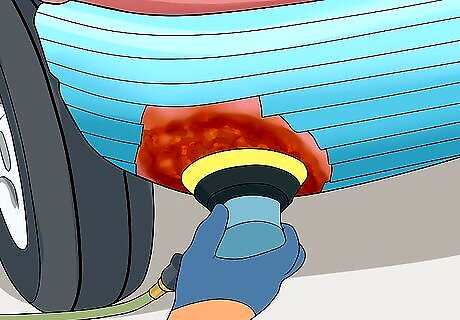
Remove the paint around the rust with a dual action (DA) sander. A DA sander gives you control over the speed of the sander while removing the paint. Start with 80 grit and work your way up to 150 grit. Use the DA sander with (80-150 grit) to take off both the primer and paint, as well as any light rust that hasn't fused with the metal, and level the surface between the painted surface and the unpainted area. After you're done, feel with your (gloved) fingers — you should now have a smooth surface.

Switch to a metal grinding wheel. Next, use a metal grinder to remove any thick rust buildups and expose any pits. When using the wheel, go slowly, because these tools can do a lot of damage to the car's body if used incorrectly. Once the grinding is done, apply rust removing acid to the area to remove the microscopic particles of rust that remain. For this job, phosphoric acid is usually best and can be bought at most auto parts stores. If you want, use a hole spot filler or a body filler like Bondo to even out some of the dents and fill the space where the paint is gone. Finish application of your filler by sanding by hand (using 120 grit sandpaper) to get a nice smooth metal surface. See below for more extensive information on using fillers.
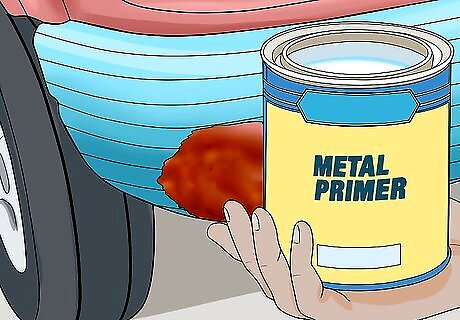
Prepare the spot for priming. Purchase primer that is ideal for painting on bare metal and an auto spray that matches the color of your car. Both of these supplies can be found at an auto supply store. Primers may vary, so follow the instructions provided with your primer or talk to an expert at the auto store for definitive information. Typically, what you will need to do to prepare is: Wipe the area with mineral spirits or paint thinner. Tape newspaper on all surrounding areas within three feet.

Apply thin, even coats of primer. Spray three coats of primer, waiting a few minutes between coats to allow each one to apply. Don't over-apply — there shouldn't be so much primer in any one coat that it drips or runs. For most primers, you'll need to allow the fresh coat to dry overnight (at least 12 hours).
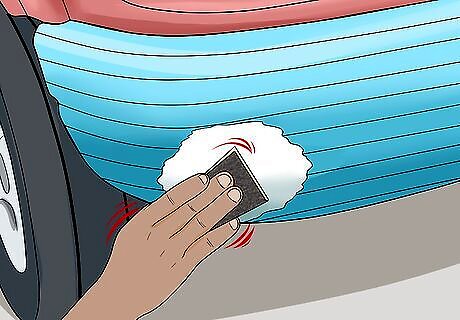
Sand with 400 grit wet sandpaper. This abrasive is specifically made for sanding between paint coats to smooth the surface and degloss so the paint bonds properly. Keep a bucket of water handy to rinse the sandpaper frequently so that it does not get fouled with paint. To finish, wash the painted area with a light soap and water mix.
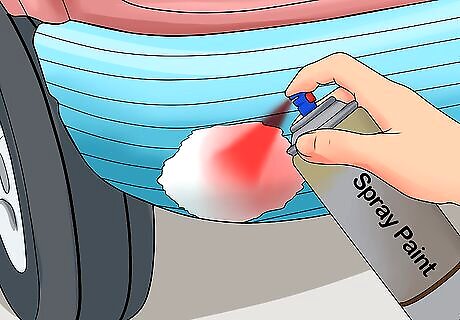
Spray a thin coat of paint. Use thin coats of paint and let each coat "rest" for a minute or two between applications so as not to let the paint run or sag. Use as many coats of paint over the primer as you need in order to achieve a nice color and finish. Let the paint set at least 24 hours before pulling off the tape. Be patient — if the paint still feels tacky, you may need more time.
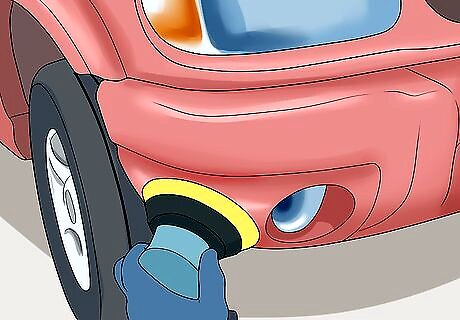
Buff the edges of the new paint so that it blends with the old paint. If necessary, apply a clear coat to match of the finish on the rest of the car. Finally, allow the paint to cure for 48 hours.
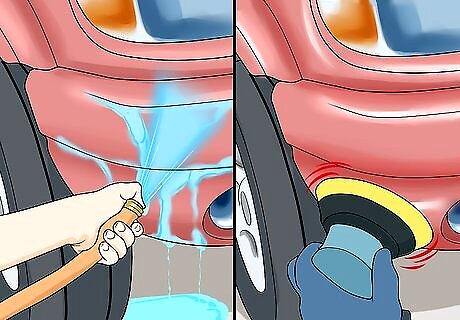
Wash and polish the car. Congratulations! Your car is now rust-free and ready to ride. As a precaution, never wax fresh paint within 30 days of painting — the scrubbing, buffing action can pull fresh paint off.
Using "Filler Patches"
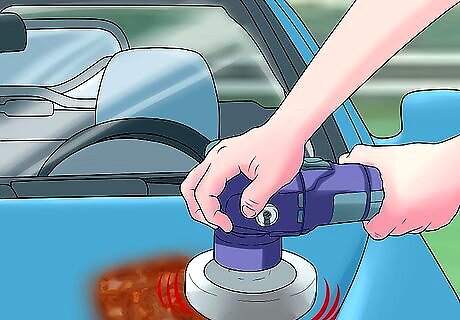
Grind rust down to "fresh steel." This method is slightly different than the one above, but works by the same basic principles and should work especially well for rust spots that have caused holes or pitting. To start, use a metal grinder to remove all of the rust. You want to grind to the point where you have "fresh" (un-rusted) steel all around where the rust spot was, even if this leaves you with a hole. Getting rid of all of the rust is crucial — if you miss even a small fleck of rust, it can corrode underneath your car's paint over time and lead to another rust spot. Keep in mind, that, because you're using a grinder, all of the safety precautions at the beginning of the page apply for this method as well. That means wearing gloves, safety glasses and especially a dust mask to keep the rust and paint particles out of your lungs.
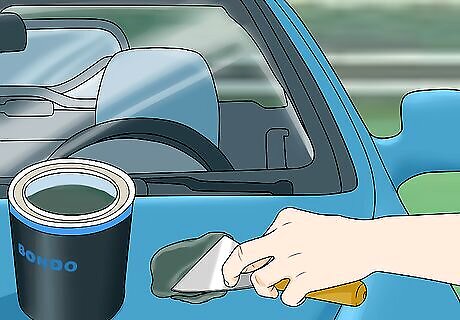
Cover the hole with a non-rusting filler. Next, you'll want to apply a filler over your former rust spot. You can buy commercial fillers (like Bondo) at most auto stores for fairly cheap. For larger holes, however, you may need to improvise. In this case, you need something flat and fairly durable that paint can bind to and that won't rust to patch the hole with. Fix this object in place with a coat of commercial filler and allow it to dry. Believe it or not, cut-up beer or soda cans work well for hole-patching purposes. The aluminum in these cans is naturally corrosion-resistant and many modern cans are coated with a thin protective layer anyway. Another good choice is thin sheets of hard plastic.
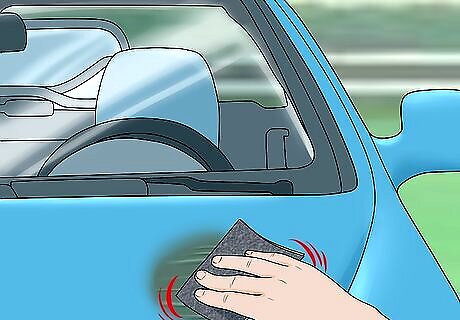
Use sandpaper to level. Next, use sandpaper to create a smooth, even surface between your new "patch" and the actual body of the car. This can be a long, tedious process — as you sand, you'll probably find that you need to add additional filler and let it dry periodically as you sand away the existing filler. The process thus becomes something along these lines: Filler, grind, filler, grind, filler, grind... (and so on). Start grinding with a rough (low grit) sandpaper to smooth out big bumps, then gradually transition to a medium and finally a fine (high grit) sandpaper for a perfectly smooth finish. Slow, steady, hand-sanding is best for this process — mechanical grinders can tear your patch away.

Mask around your work area. Next, you need to apply a fresh coating to your newly-repaired rust spot. To prepare for this, you'll need to mask most of your car to protect it from primer paint, and other airborne particles. Don't forget your windows and tires. Try to have the edges of your masking aligned with existing seams in the body of the car to hide minor differences between your new paint and the old paint (unless you're experienced enough to produce a smooth blend).

Apply primer, then paint. Apply a few thin coats of primer, allowing each coat a minute or two to adhere before you reapply on top of it. Let the primer dry overnight, then, after about 12 hours, give it a sanding with wet 400 grit sandpaper so that the paint can adhere properly. When you're ready, apply your paint on top, using a similar "spray one thin coat at a time and let it dry" strategy as you used for the primer. You may want to buff out the edges of your paint and/or cover with a clear coat layer so that this section matches the finish on the rest of your car. Obviously, it's important to pick a paint that matches your car's current finish. There is a specific paint color code for each vehicle that can be found on a sticker somewhere in the vehicle. This information is needed in order to match the color up. Most auto paint shops will be more than happy to help you with this. Keep in mind, however, that the paint on older cars can gradually discolor over time.










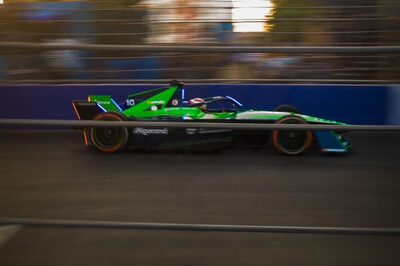

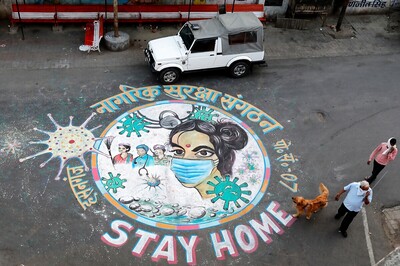

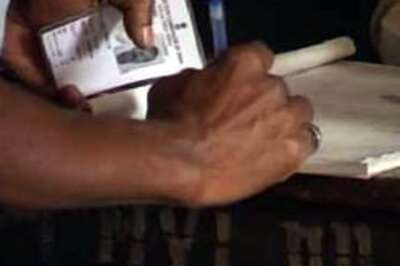

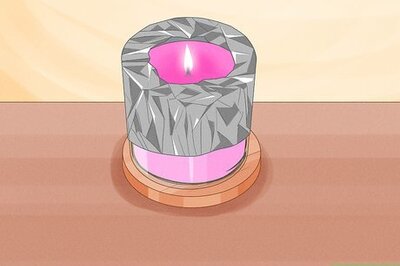



Comments
0 comment